From Rome to Jamón: A Journey Through the Quiet Majesty of Extremadura
Ever heard of Extremadura? Don’t worry if you haven’t – this region in western Spain is one of the country’s best-kept secrets! Imagine a place where ancient Roman ruins stand tall, medieval towns whisper tales of knights and conquistadors, and the most delicious ham you’ve ever tasted comes from pigs happily munching on acorns. Ready to explore?
21 ESCAPESSPAIN
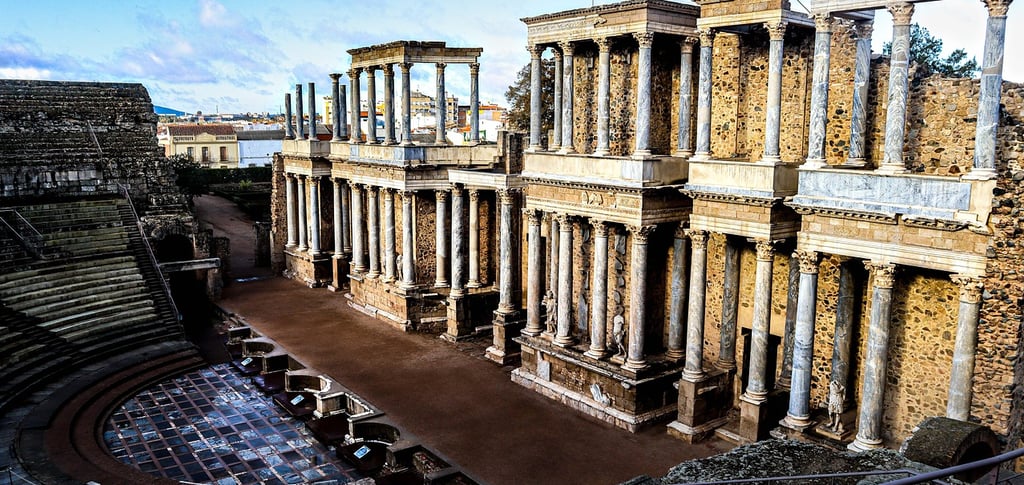

Where Empires Walked: Roman Mérida
Extremadura’s landscape is dotted with remarkable Roman ruins, testament to the region’s importance during the Lusitanian era. In Mérida, once the capital of Lusitania, visitors can explore an incredibly preserved Roman theater, amphitheater, and the longest surviving Roman bridge in the world at 790 meters spanning the Guadiana River. These structures not only serve as tourist attractions but also as living reminders of the region’s Roman past, with the theater still hosting the annual International Festival of Classical Theatre.
The National Museum of Roman Art is a must-stop, housing mosaics and sculptures excavated right from beneath your feet. The Lusitanian period set the stage for Extremadura to become a cultural melting pot. Following the Romans, the region saw influences from Visigoths, Moors, and Christians, creating a rich tapestry of cultural heritage.
Trust me, walking around these sites is like stepping straight into a history book!
Tip: get there early to watch the sunrise over the roman theater, it is well worth it. Rooftop Views: Take advantage of the rooftop terrace at ILUNION Mérida Palace for stunning views of the city, especially at sunset.
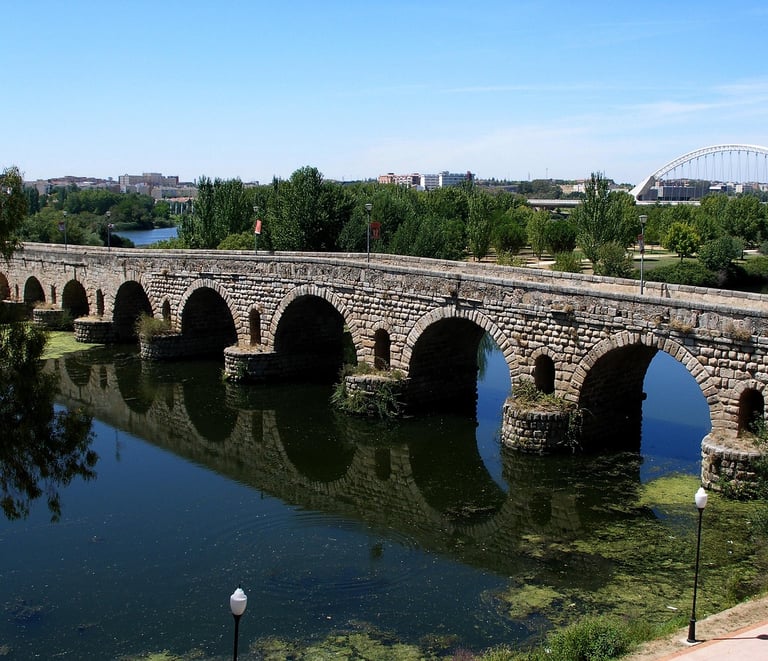

Medieval Stones and Noble Legends: Cáceres
Next up, let’s head to Cáceres and Trujillo, driving north, the landscape turns rugged, olive trees giving way to oak forests and rolling plains. Cáceres suddenly rises like a mirage, a perfectly preserved medieval town wrapped in time. Its old quarter is a labyrinth of stone streets, towers, and archways, declared a UNESCO World Heritage site for good reason.
As you enter through the Arco de la Estrella—the main gateway to the walled city—you step into a perfectly preserved world of medieval Spain. Just beyond lies the Plaza de Santa María, home to the striking Catedral de Santa María, where Romanesque roots blend with Gothic and Renaissance details. Climb the 12th-century Torre de Bujaco for sweeping views over the main square and rooftops. At the city’s highest point, Plaza de las Veletas offers not only beautiful views but also the Museo de Cáceres, where you can see a fascinating Islamic-era cistern beneath the building. And don’t miss a quiet stroll through the Judería Vieja, the old Jewish quarter, where whitewashed houses and narrow lanes tell stories of the city’s layered past.
Cáceres is not just a city frozen in medieval stone—it’s a place where the past still breathes through living traditions, especially during Holy Week. Declared a Festival of International Tourist Interest, the Semana Santa processions in Cáceres trace their roots back to the 15th century, blending spiritual devotion with powerful theatricality. The most haunting is the midnight procession of the Cristo Negro, held every Holy Wednesday. In the silence of the night, hooded brothers dressed in black carry a 13th-century wooden crucifix—the Black Christ of Cáceres—through the dimly lit streets, their path lit only by torches, their steps echoing with solemn reverence. Beyond Holy Week, the city transforms each year with the Medieval Market of the Three Cultures, a vibrant celebration of the Christian, Muslim, and Jewish communities that once coexisted within Cáceres’ walls. The streets come alive with performers, artisans, and food stalls that bring the spirit of medieval life into the present. Adding to the richness are the traditional costumes and embroidery found in local festivals and villages, each design telling its own story in bright threads and intricate patterns. Together, these customs weave a vivid cultural tapestry, allowing visitors to step not just into Cáceres’ history—but into its heart.
Trujillo, a town built by conquistadors
Just 45 minutes away is Trujillo, a town built by conquistadors. This is where Francisco Pizarro was born, and his statue looms large in the main plaza.
Trujillo’s charm centers around its grand Plaza Mayor, a lively square surrounded by centuries-old palaces and mansions that once belonged to noble families and conquistadors. Rising above the town is the Castillo de Trujillo, a medieval fortress offering panoramic views and a glimpse into the town’s strategic past. Just a short walk away, the Iglesia de Santa María la Mayor stands as a testament to Trujillo’s religious and architectural heritage, with its blend of Romanesque and Gothic styles. The Palacio del Marqués de la Conquista, with its ornate façade, reflects the wealth and influence of the nobility, while the nearby Palacio de Orellanas-Pizarro showcases the legacy of Trujillo’s most famous son, Francisco Pizarro. Completing the scene is the Iglesia de San Martín, a graceful medieval church that anchors one side of the main square, adding to the town’s timeless atmosphere.
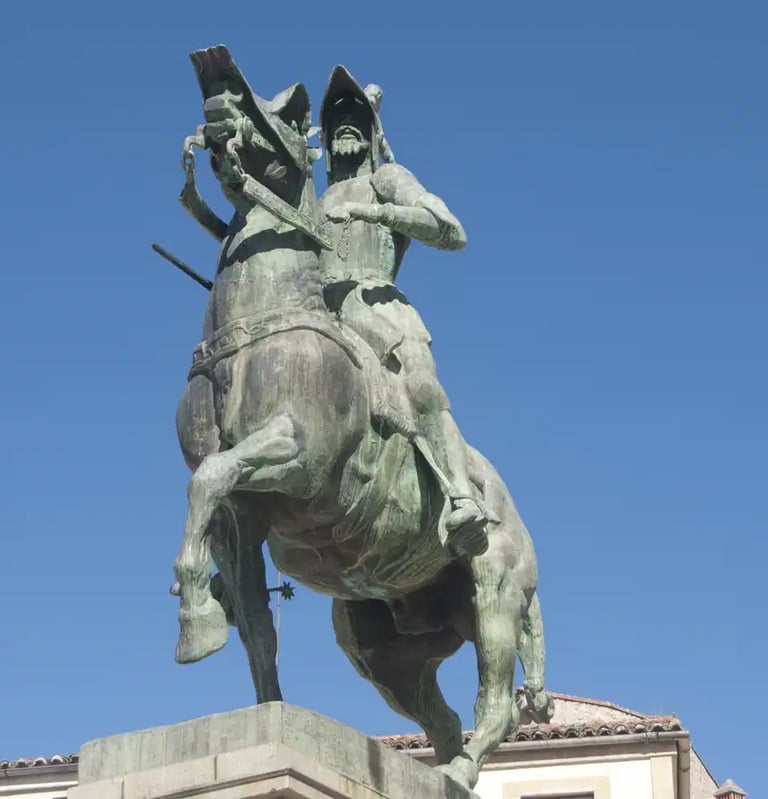

Ham Heaven in the Dehesa
Now, let’s talk about food! Extremadura is famous for its jamón ibérico, one of the most iconic symbols of Extremadura, a product born from centuries of tradition, the unique landscape, and an unmatched level of craftsmanship. The art of curing ham here dates all the way back to Roman times, when preserving pork was a practical necessity.
The secret? The pigs roam freely in the dehesa,—a vast and beautiful stretch of oak-studded pastureland where Iberian pigs roam freely, especially during the montanera season when they feast on acorns. These lucky pigs feast on acorns, rich in oleic acid, give the ham its unmistakable nutty flavor and buttery texture.


Add to this the Extremaduran climate, with hot summers and cold winters, and you have the perfect conditions for curing the hams slowly—often for up to three years.
If you’re a ham lover, you absolutely have to try jamón ibérico de bellota – it’s the crème de la crème! Imagine thinly sliced, melt-in-your-mouth ham that tastes like the very essence of Extremadura. Seriously, it’s that good. If you want to see the jamón production process and sample a great variety of jamón ibérico head to Sierra de Montánchez!
Where to Stay & What to Savor Along the Way
Mérida:
Stay at the Parador de Mérida, set in an 18th-century convent right in the heart of the city. Its peaceful courtyards and Roman artifacts set the tone for what’s to come. Akla Hotel Mérida: For a more intimate experience, this charming hotel is housed in a 19th-century home and offers a spa area. Hotel ILUNION Mérida Palace: A posh hotel with a rooftop pool offering panoramic views of the city. Its location in Plaza de España puts you right in the heart of Mérida.
For dinner, try Casa Benito, a local favorite tucked behind the Roman Theater—simple, rustic, and full of local flavor, from migas to cordero asado. If you’re after a modern twist, A de Arco offers a creative tasting menu rooted in Extremaduran ingredients.
Cáceres:
For a stay steeped in medieval elegance, book a night at the Atrio Restaurante Hotel, a boutique luxury hotel within the old town walls that also boasts a two-Michelin-starred restaurant—ideal for travelers seeking a high-end culinary experience with wine pairings to match. Casa Pizarro Hotel: Set in an 18th-century house near Plaza Santa Clara, offering a charming historical experience. Hospes Palacio de Arenales: A 5-star hotel in a 17th-century noble residence, complete with wellness center and sp
For a hearty meal, visit Tapería Yuste for tostas, cheeses, and local wines, or stop by La Cacharrería, known for its cozy vibe and traditional tapas with a twist.
Trujillo:
Spend the night at the Eurostars Palacio de Santa Marta, a beautifully restored 16th-century palace just steps from Plaza Mayor. For something more rustic, Posada Dos Orillas offers boutique charm within the old Jewish quarter.
When hunger strikes, don’t miss La Alberca Asador, where the grilled meats and views over the countryside are unforgettable. Or enjoy sunset drinks and tapas at El 7 de Sillerías, a relaxed bistro tucked into one of the town’s winding alleyways.
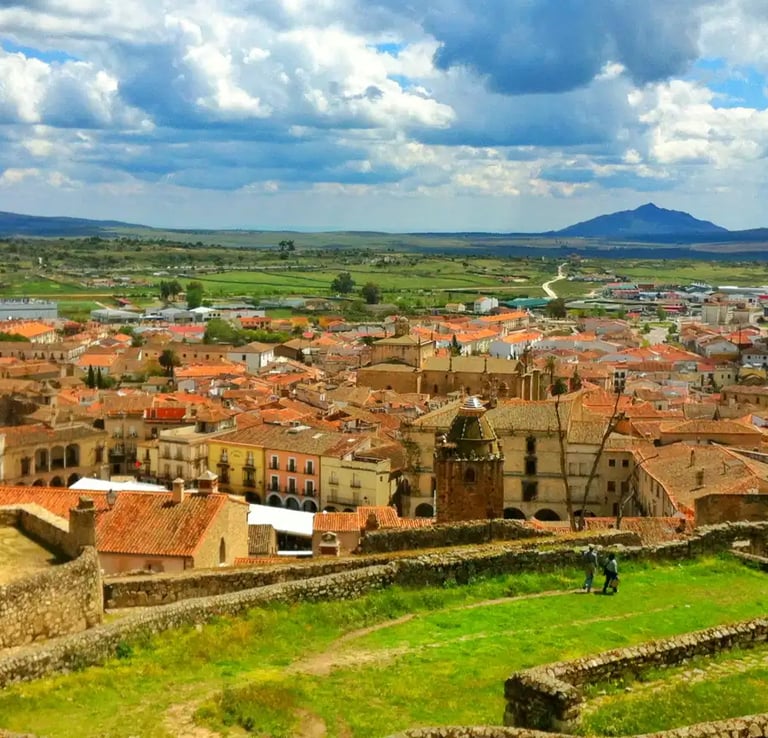

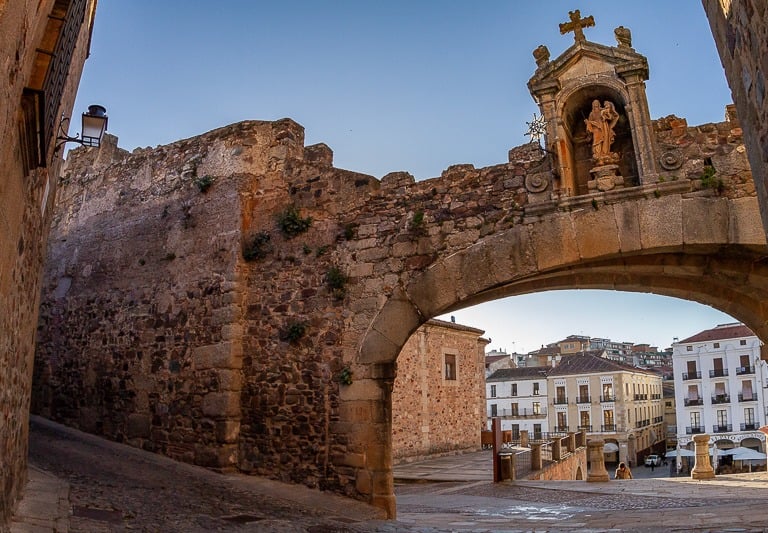

Insider Tips for Exploring Extremadura
Rent a car: Public transportation between towns is limited—driving gives you the freedom to stop at scenic overlooks, vineyards, and jamón producers hidden in the dehesa.
Book early for Holy Week: Cáceres gets booked out quickly during Semana Santa—especially around the Cristo Negro procession.
Don’t rush: These towns are best enjoyed slowly. Take time to wander side streets, chat with locals, and sample regional wines like Ribera del Guadiana.
Pack layers: Extremadura’s climate swings from hot days to cool evenings, especially in spring and fall.
Stop for ham tastings: Villages like Montánchez, Jerez de los Caballeros, and Monesterio offer tastings and tours of family-run secaderos (curing houses)—some even include lunch with panoramic views.
Watch the sky: With little light pollution, Extremadura is a fantastic place for stargazing, especially near Trujillo or Monfragüe National Park.
So, what are you waiting for? Pack your bags and get ready to discover Extremadura! This hidden gem of Spain offers a perfect blend of history, culture, and delicious food. You’ll leave with memories (and a full belly!) that will last a lifetime.
Crunia Travel
Customized travel experiences await you.
Get in touch
hello@cruniatravel.com
+1 754 457 2624
© 2025. All rights reserved.


admin@cruniallc.com
